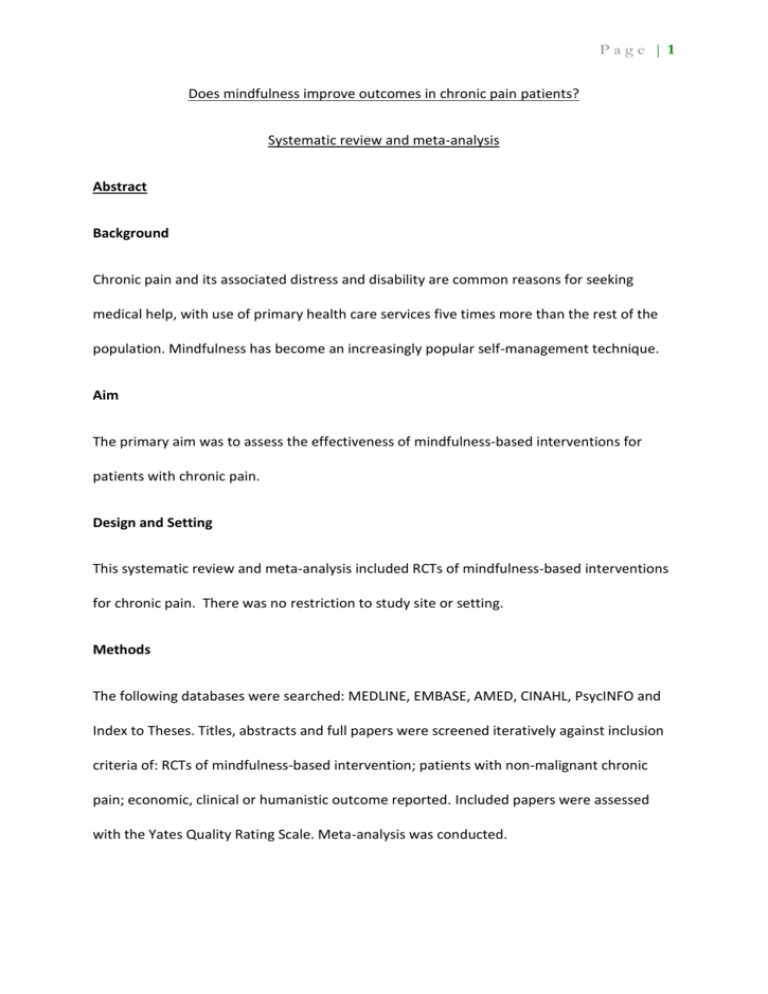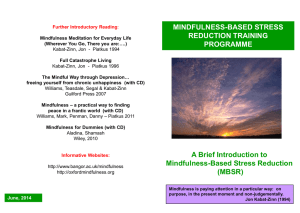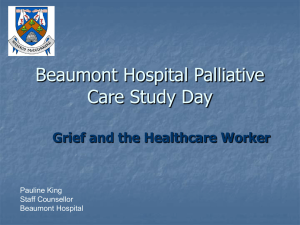Manuscript_with_tracked_changes_made
advertisement

Page |1 Does mindfulness improve outcomes in chronic pain patients? Systematic review and meta-analysis Abstract Background Chronic pain and its associated distress and disability are common reasons for seeking medical help, with use of primary health care services five times more than the rest of the population. Mindfulness has become an increasingly popular self-management technique. Aim The primary aim was to assess the effectiveness of mindfulness-based interventions for patients with chronic pain. Design and Setting This systematic review and meta-analysis included RCTs of mindfulness-based interventions for chronic pain. There was no restriction to study site or setting. Methods The following databases were searched: MEDLINE, EMBASE, AMED, CINAHL, PsycINFO and Index to Theses. Titles, abstracts and full papers were screened iteratively against inclusion criteria of: RCTs of mindfulness-based intervention; patients with non-malignant chronic pain; economic, clinical or humanistic outcome reported. Included papers were assessed with the Yates Quality Rating Scale. Meta-analysis was conducted. Page |2 Results Eleven studies were included. Chronic pain conditions included: fibromyalgia, rheumatoid arthritis, chronic musculoskeletal pain, failed back surgery syndrome, and mixed aetiology. Papers were of mixed methodological quality. The main outcomes reported were: Pain intensity, depression, physical functioning, quality of life, pain acceptance and mindfulness. Economic outcomes were rarely reported. Meta-analysis effect sizes for clinical outcomes ranged from 0.12 (-0.05, 0.30) (depression) to 1.32 (-1.19, 3.82) (sleep quality), and for humanistic outcomes 0.03 (-0.66, 0.72) (mindfulness) to 1.58 (-0.57, 3.74) (pain acceptance). Studies with active, compared to inactive, control groups showed smaller effects. Conclusions There is limited evidence for effectiveness of mindfulness-based interventions for patients with chronic pain. Better quality studies are required. Keywords Chronic pain; Mindfulness; Primary health care; Review; Meta-analysis How this fits in Systematic reviews to date on this topic have included both randomised and nonrandomised trials, and have focused on clinical outcomes such as pain. Two recent systematic reviews1, 2 have been condition-specific, including only fibromyalgia trials or only low back pain trials. This review looks at management of non-malignant chronic pain as a whole, includes only RCTs and uniquely focuses on humanistic outcomes such as pain Page |3 acceptance and perceived pain control, which are of particular relevance with this self-help technique, as well as clinical and economic outcomes. Introduction Chronic pain is a common condition.3 Patients with chronic pain use primary health care services up to five times more often than the rest of the population.4 Mindfulness meditation has become an increasingly popular self-management technique for many long term conditions, including chronic pain. Mindfulness originates from a Buddhist contemplative tradition, and involves self-regulated attention, maintained on immediate experience, and held within an orientation of curiosity, openness and acceptance.5The most frequently cited method of mindfulness training is the secular Mindfulness-Based Stress Reduction programme (MBSR). Mindfulness meditation practices are taught over 8-10 weeks, with weekly group sessions and daily home practice.6,7 Mindfulness-Based Cognitive Therapy (MBCT) blends features of Cognitive Therapy with the techniques of MBSR.8 The goal of mindfulness-based interventions is not to alter the experience per se but to change how individuals respond to the experience.9 In this way it may be complementary to medical treatments that target physical symptoms. There is significant variability in implementation of mindfulness programmes within the NHS. In a UK-wide survey of professionals involved in teaching or implementing mindfulness within the NHS10, 59 % of respondents reported no or minimal service provision. Where programmes were offered, availability for patients was variable, with recurrent depression the most common eligible condition (78%), reflecting National Institute for Health and Care Excellence (NICE) guidelines11. Where mindfulness programmes were offered, under half Page |4 (47%) of respondents reported availability for patients with other conditions such as chronic pain or fatigue.10 Previous reviews on mindfulness-based interventions for patients with chronic pain have focused on clinical outcomes12, 13. Humanistic outcomes measure the consequences of a disease or condition on life, (e.g. physical functioning, health-related quality of life), or moderate the effects of a disease or condition on life (e.g. perceived pain control, pain acceptance).14 Only two humanistic outcomes (physical wellbeing and quality of life) have been included previously in a meta-analysis13, which shows a statistically significant effect of mindfulness on these outcomes. Given the goal of mindfulness-based interventions9, the measurement of humanistic outcomes was considered to be important, and this was explored in this review. Aim & Objectives The aim of the systematic review was to assess the effects of mindfulness-based interventions for patients with chronic pain on economic, clinical and humanistic (ECHO)14 outcomes. The objectives were to: systematically identify randomised controlled studies looking at effects of a mindfulness-based intervention for patients with chronic pain compared with an active or inactive control group; assess these studies on standard quality criteria; carry out a meta-analysis; describe the effects shown in these studies on the ECHO14 outcomes. Page |5 Methods Literature Search The MEDLINE, EMBASE, AMED, CINAHL, PsycINFO and Index to Theses, electronic databases were systematically searched to identify eligible studies on April 3rd2013. (See appendix 1 for search strategy). Search terms including chronic pain conditions and mindfulness were used in various combinations with relevant Boolean operators. Inclusion and exclusion criteria Study populations and sites There were no limitations on age, ethnicity or gender of study populations, nor sites. Chronic pain was defined as pain persisting for thirteen weeks or longer.15 To minimise heterogeneity in the sample, studies of patients solely with irritable bowel syndrome, multiple sclerosis, chronic fatigue syndrome or with malignant pain, were excluded. Interventions Studies on Mindfulness-based interventions for chronic pain were considered if they followed the standard Mindfulness-Based Stress Reduction (MBSR) or Mindfulness-Based Cognitive Therapy (MBCT) format. Studies using modifications of the standard MBSR or MBCT courses were considered if they included group based mindfulness meditation tuition and a course length at least 6 weeks. Page |6 Study design Studies were included if they were randomised controlled trials with active or inactive control groups. There were no restrictions on dates, language or publication status. Outcomes Studies were included that measured any combination of economic, clinical or humanistic outcomes at the end-of-intervention point.14 Data management The list of titles and abstracts were screened by one reviewer (FB) against the inclusion and exclusion criteria in two separate stages and excluded as appropriate. Full text papers were retrieved and reviewed against the inclusion criteria, and reasons for exclusion of studies at the full text stage were recorded for each study. Outcomes, data extraction and quality assessment The effect of mindfulness on outcomes was compared at eight weeks (i.e. at the end of a standard mindfulness programme) between intervention and control groups. A data extraction tool was developed and piloted to be applied to all included studies. This included fields for describing the economic, clinical and humanistic outcomes and all items from the quality rating scale developed by Yates et al. (2005).16 The Yates Quality Rating Scale has been developed to assess the quality of RCTs of psychological trials for chronic pain. Studies were not excluded based on quality, however study quality was taken into account when discussing outcomes. Independent duplicate data extraction was undertaken for each included study. Discrepancies were resolved through discussion between data extractors and a third independent opinion sought where consensus could not be reached. Page |7 Analysis The standardised mean difference (SMD) using the Hedges’ g formula was calculated as an effect size measure for all outcomes. (Hedges’ g is abbreviated to ‘g’ in the remainder of this paper.) Results were scaled so that a positive effect size means that the study favours the intervention group compared with the control group. 95% confidence intervals (95% CI) were reported for effect sizes. Statistical significance was defined for this review as having a 95% CI that did not include zero. For the three 3-armed trials18,27,29, the following pooling formulae17 were used to combine the two control groups, to allow a single between group SMD to be calculated (N= sample size, M= mean, 1= group 1, 2= group 2, SD = standard deviation). 𝑃𝑜𝑜𝑙𝑒𝑑 𝑁 = 𝑁1 + 𝑁2 𝑃𝑜𝑜𝑙𝑒𝑑 𝑆𝐷 = √ 𝑃𝑜𝑜𝑙𝑒𝑑 𝑀𝑒𝑎𝑛 = 𝑁1 𝑀1 + 𝑁2 𝑀2 𝑁1 + 𝑁2 𝑁1 𝑁2 (𝑀2 − 𝑀22 − 2𝑀1 𝑀2 ) 𝑁1 + 𝑁2 1 𝑁1 + 𝑁2 − 1 (𝑁1 − 1)𝑆𝐷12 + (𝑁2 − 1)𝑆𝐷22 + The pooling formulae were also used to combine results where they were presented only as subgroups.18 For the cluster-randomised study18, results were adjusted for the effect of clustering, in accordance with standard practice (Cochrane Handbook 16.3.4).17 Where data were judged to be of sufficient quality and homogeneity, SMDs were combined in a random-effects meta-analysis using RevMan software. This model was chosen due to the diversity of study designs, chronic pain conditions and control groups. The level of Page |8 heterogeneity between study results was measured for each combined result using the 𝜒2 test. The I2 statistic was calculated to represent the impact of heterogeneity.17 Subgroup analyses investigated differences in effect according to whether the control group was active or inactive. Quality of evidence The GRADE recommendations19 were used to judge the quality of the evidence and the strength of recommendations given in this review. Results Of the 2463 titles identified, eleven studies were eligible for inclusion (see Figure 1).18,20¬30. Figure 1 to appear here Included studies Of the included studies, eight were conducted in USA18,20¬22,24-28, one in Germany29, one in Hong Kong30 and one in UK23. The majority of participants were female (with exception of one study24), and Caucasian (with the exception of the one study30). The mean age of participants ranged from 47 to 52 years, except the two studies with older adults25,26 (mean age 75). The majority of participants had completed secondary education and /or had a college qualification. Where employment status was reported, the majority were either employed or retired.20,21,25,26,29,30 Chronic pain populations studied were: fibromyalgia (3 studies)20-22,29, rheumatoid arthritis (2 studies)18,28, chronic musculoskeletal pain (2 studies)23,27, failed back surgery syndrome (1 study)24, and mixed aetiology (3 studies)25,26,30. Page |9 Control groups included: active comparator (6 studies)18,22,25,27,29,30, waiting list control group (5 studies)20,21,24,26,28,29 and standard care (2 studies)23,27. Active comparators were educational control group18,22,25,29, massage27, multidimensional pain intervention (mainly educational)30 and CBT for pain18. There were three 3-armed studies18,27,29. Ten studies were randomised by patient20-30and one was cluster randomised18. Only four studies18,20,29,30 had involved sample size calculations and were adequately powered to detect an effect. Of the remaining seven studies, four were feasibility or pilot studies with small sample sizes2427, one failed to recruit28 and two to retain22,23 target numbers. Included studies and their characteristics are displayed in Table 1. Four studies looked at economic outcomes: prescribed and over-the-counter medication use (three studies)22,24,29, use of complementary/alternative therapies (one study)22, doctors’ appointments (two studies)22,29 and sickness absence from work (one study)30. All eleven studies looked at clinical outcomes: pain intensity (eight studies)18,22-27,30; depressive symptoms (six studies)18,20,22,28-30. Only three studies25,26,28 specifically collected data on adverse events but in practice none were reported. Health-related quality of life (6 studies)23,25-27,29,30and physical functioning (5 studies)22,24-26,29 were the most commonly reported humanistic outcomes. Three studies measured patientcentred outcomes (personal treatment goals29, personal value of components of intervention28, global impression of change25 and perceived success at helping their back problem25). All outcomes measured are shown in Figure 2 P a g e | 10 Figure 2 to appear here. Study Quality and Risk of Bias The Yates Quality Rating Scale scores of included studies varied from 10 to 31 points out of 35. The quality criteria commonly not met by studies included: adherence to manual (ten studies20-30), six month follow up (nine studies20-29), attrition bias (differential rates of attrition between groups) (eight studies20-22,24-27,29,30), performance bias (differential equivalence in treatment expectations between groups) (eight studies18,20-24,26-28), and selection bias (independent allocation bias) (seven studies20-24,27-29). The quality rating for each of the studies is illustrated in Figure 3. There is also the wider issue of publication bias that may have arisen due to dissemination of research findings being influenced by the nature and direction of results. 17 Due to the small number of included studies, a funnel plot was not appropriate. Figure 3 to appear here. Recruitment and Attrition Recruitment to studies was generally by advertisements (posters, flyers and at health fairs). An average of 47% of participants assessed and invited were randomised (range 4%23 to 87%24). Rates of attrition from studies are shown in table 1. Drop-out from the mindfulness intervention ranged from 2%18 to 50%27 (median 20%), and drop-out from the mindfulness 8 week programme was higher than from active control group programmes, with two exceptions18,22. Loss to follow-up ranged from 8-50% of intervention groups (median 20%) and from 0-52% of control groups (median 11%). Individual studies reported that drop-outs P a g e | 11 had a lower level of education (p=0.05)26, were older (p=0.03)25, and had greater baseline symptom severity (p=0.005)20,21 and poorer physical functioning (p=0.05)20,21. Economic outcomes Only four studies22,24,29,30 reported an economic outcome. In two studies22,29, the results of economic outcomes were unavailable. In one study30 reporting sickness absence from work, results were non-significant. One small study24 reported significantly reduced analgesic use in the mindfulness group. The following sections report results of meta-analyses for outcomes reported by more than one study for mindfulness compared with any control group. These are shown in Table 2, which also reports the subgroup analyses. Clinical Outcomes a) Physical health outcomes Pain intensity was the most reported pain outcome (eight studies18,22-27,30 with a combined effect size of 0.16 (-0.03, 0.36), (I2 = 0%)). Two studies24,29 measured sleep quality (combined effect size: 1.32 (-1.19, 3.82) but this meta-analysis had some evidence of heterogeneity (I 2 = 95%)). b) Mental health outcomes Six studies18,20,22,28-30reported depression symptoms (combined effect size: 0.12 (-0.05, 0.30), (I2 =0%)) and two studies29,30measured trait anxiety (combined effect size: 0.10 (-0.15, 0.36), (I2 =0%)). P a g e | 12 Humanistic Outcomes a) Health-related quality of life (HRQoL) Four studies22,26,27,30 reported both a physical health component of HRQoL (combined effect size: 0.16 (-0.15, 0.47), (I2 = 8%)) and a mental health component (combined effect size of 0.37 (-0.07, 0.82), (I2 = 46%)). b) Physical functioning Five studies22,24-26,29reported physical functioning (combined effect size: 0.22 (0.00, 0.45), (I2=0%)). c) Pain-related humanistic outcomes Pain-related humanistic outcomes were looked at in six studies18,22-26. There was a combined effect size of 1.58 (-0.57, 3.74) for pain acceptance (two studies24,26) (I 2 =91%) and of 0.58 (0.23, 0.93) for perceived pain control (two studies18,23) (I2=0%). d) Mindfulness There was a combined effect size of 0.03 (-0.66, 0.72) for mindfulness (four studies23,25,28,29) with some evidence of heterogeneity (I 2 =85%). e) Other outcomes For patient-centred outcomes21,25,28,29, results from mindfulness groups were generally positive but validated scales were often not used. P a g e | 13 Table 1: Methodological details of individual RCTs included to appear here Table 2: Meta-analysis results to appear here Figure 4: Forest plots with meta-analysis data for selected outcomes to appear here Discussion Summary This systematic review found limited evidence for the effectiveness of mindfulness-based interventions in chronic pain. Individual studies were generally small and results for most outcomes were not statistically significant. Meta-analysis revealed that mindfulness-based interventions may have a positive impact on perceived pain control with a moderate effect size (g=0.58), but there was no evidence of a benefit in terms of clinical outcomes such as pain intensity or depression. Separate subgroup analysis restricted to trials with inactive control groups found some evidence of improved physical functioning and quality of life (mental health component). When studies with active control groups were looked at separately, the effect of mindfulness was generally found to be equivalent to the active comparator. Included studies were of mixed methodological quality. Strengths and limitations As with all reviews, despite a rigorous search process some studies may have been missed. Title and abstract screening was carried out by just one reviewer and not duplicated. Some of the pooled effects were based on small numbers of studies. Trait anxiety, sleep quality, pain acceptance and perceived pain control were based on combining only two studies each. The random-effects model was selected for the meta-analysis due to the P a g e | 14 heterogeneity of study designs, outcome measures and study results. This model may not be appropriate when combining as few as two studies due to the difficulty with estimating between-study variability, but it was thought appropriate to present results using a consistent approach. Included studies had their own limitations; seven studies22-28small sample sizes and may have been underpowered to detect an effect. Secondly recruitment method and participation rates will have resulted in self-selected samples. Retention in mindfulnessbased intervention groups was poor and only four studies20,26,29,30 carried out ITT analysis. Including studies which only analysed programme completers as well as those that used ITT analysis may have resulted in bias favouring treatment. Fidelity to the intervention as delivered was often not assessed20-24,27,29. It is unknown whether participants were engaging in daily home practice as recommended. Frequency of practice may affect outcomes as seen in one included study (Pradhan et al 2007)28. Additionally not all interventions included all recommended components of an MBSR or MBCT programme. For example, three18,25,26 of the included studies did not involve mindful movement, and six18,22,23,25-27did not include an all-day practice session. Only two23,29 had mindfulness programme facilitators with any specific training or experience in delivering the programme to patients suffering from chronic pain. Comparison with the existing literature The previous meta-analysis13 that included other acceptance-based interventions as well as MBSR and non-randomised studies, found small effects on pain, depression and physical wellbeing. This current review including only RCTs and only MBSR found no significant effect P a g e | 15 on clinical outcomes. It also uniquely found that studies comparing mindfulness with inactive control groups were more likely to show significant effect on humanistic outcomes, than comparisons with active control groups. Implications for research and/or practice GRADE recommendations The strength of the recommendation of mindfulness-based interventions for patients with chronic pain based on effects found in this review is weak. Most effects were not statistically significant when compared to controls and when pooled in meta-analysis. According to GRADE19, the quality of evidence in this review is low (RCTs were often small, results inconsistent with wide confidence intervals, and heterogeneity between studies) (See Cochrane handbook 12.2.1)17. Further research is likely to have an important impact on our confidence in the estimate of effect and may change the estimate. The outcome measures recommended by IMMPACT31 include pain, and the most commonly reported outcomes in the included studies were pain and depression. It is questionable whether pain intensity and other clinical outcomes are the most appropriate outcomes to measure, given that the goal of mindfulness-based interventions is not necessarily to alter the symptom experienced but rather to increase self-management and coping.9 There is, however some preliminary evidence from small neuroimaging studies that pain perception may be influenced by meditation. 32 Evidence for a statistically significant effect of mindfulness was found only for humanistic outcomes. This reinforces the need to choose appropriate outcomes to assess an intervention. Surprisingly, however, this review did not find evidence of statistically P a g e | 16 significant improvement in pain acceptance or mindfulness. The result of no significant change in pain acceptance was based on two very small studies which had high heterogeneity24,26. Mindfulness improved in the intervention group over the control in only two23,29 of the four23,25,28,29 included studies that measured it. Three23,25,28 of the studies, however, used the Mindful Attention and Awareness Scale (MAAS) as their measure of mindfulness, which is unidimensional and has been found to be less sensitive to change in novice meditators.33 Suggestions for future research would be: firstly, to measure humanistic outcomes and outcomes of value to patients; secondly to measure mindfulness using a multidimensional scale that is more sensitive to change in novice meditators, such as the Kentucky Inventory of Mindfulness Skills (KIMS) or the Five Facet Mindfulness Questionnaire (FFMQ)34 , and finally, given the high attrition rates from mindfulness-based interventions, research is needed to address retention issues before progressing to an adequately powered, appropriately controlled trial. Additional information Funding Funding for the primary author was provided by the following NHS Education Scotland fellowships: Scottish Clinical Research Excellence Development Scheme (SCREDS) Clinical Lecturer fellowship; Academic Fellowship in General Practice. No other external funding was awarded. Ethical approval P a g e | 17 N/A Competing interests None Acknowledgements N/A References 1. Cramer H, Haller H, Lauche R, Dobos G. Mindfulness-based stress reduction for low back pain. A systematic review. BMC Complem Altern M 2012,12:162 2. Lauche R, Cramer H, Dobos G, Langhorst J, Schmidt S. A systematic review and meta-analysis of mindfulness-based stress reduction for the fibromyalgia syndrome. J Psychosom Res75 (2013) 500- 510 3. Elliott AM, Smith BH, Penny KI, Smith WC, Chambers WA. The epidemiology of chronic pain in the community. Lancet 1999; 354: 1248¬1252. 4. Von Korff M, Wagner EH, Dworkin SF, Saunders KW. Chronic pain and the use of ambulatory healthcare. Psychosom Med 1991; 53(1): 61–79. 5. Bishop S, Lau M, Shapiro S, Anderson ND et al. Mindfulness: A proposed operational definition. Clin Psychol Sci Prac 2004; Autumn; 11,3: Health Module pg. 230. P a g e | 18 6. Baer R. Mindfulness training as a clinical intervention: A conceptual and empirical review. Clin Psychol Sci Prac 2003; 10: 125–143. 7. Kabat-Zinn J. Full Catastrophe Living: How to cope with stress, pain and illness using mindfulness meditation. Piatkus, 1996. ISBN 0-7499-1585-4. 8. Centre for Mindfulness Research and Practice, Bangor University. http://www.bangor.ac.uk/mindfulness/about.php.en. Accessed 02/02/12. 9. McCracken L, Gauntless-Gilbert J, Vowles K. The role of mindfulness in a contextual cognitive-behavioural analysis of chronic pain-related suffering and disability. Pain 2007;131: 63-69. 10. Crane RS, Kuyken W. The Implementation of Mindfulness-Based Cognitive Therapy: Learning From the UK Health Service Experience. Mindfulness, 2012; DOI 10.1007/s12671-012-0121-6 11. National Institute for Clinical Excellence (NICE) (2009). Depression: the treatment and management of depression in adults (update). Clinical Guideline 90; retrieved from http://www.nice.org.uk/CG023NICEguideline 12. Chiesa A, Serretti A. Mindfulness-based interventions for chronic pain: A systematic review of the evidence. J Altern Complem Med 2011; 17(1): 83¬93. 13. Veehof M, Oskam M, Schreurs K, Bohlmeijer E. Acceptance-based interventions for the treatment of chronic pain: A systematic review and meta-analysis. Pain 2011; March; 152(3): 533¬542. P a g e | 19 14. Gunter M. The role of the ECHO model in outcomes research and clinical practice improvement. Am J Manag Care 1999; Apr; 5(4 Suppl): S217¬24. 15. Classification of chronic pain. Descriptions of chronic pain syndromes and definitions of pain terms. Prepared by the International Association for the Study of Pain, Subcommittee on Taxonomy. Pain Sup 1986; 3: S1¬S226. 16. Yates SL, Morley S, Eccleston C, de C Williams AC. A scale for rating the quality of psychological trials for pain. Pain 2007; 117: 314–325. 17. Higgins JPT, Green S (editors). Cochrane Handbook for Systematic Reviews of Interventions Version 5.1.0 [updated March 2011]. The Cochrane Collaboration, 2011. Available from www.cochrane-handbook.org. Accessed 12/09/13. 18. Zautra AJ, Davis MC, Reich JW et al. Comparison of cognitive behavioral and mindfulness meditation interventions on adaptation to rheumatoid arthritis for patients with and without history of recurrent depression. J Consult Clin Psych 2008; 76(3): 408¬421. 19. Guyatt GH, Oxman AD, Vist GE, Kunz R, Falck-Ytter Y, Alonso-Coello P et al. GRADE: an emerging consensus on rating quality of evidence and strength of recommendations. BMJ 2008;336:924 20. Sephton SE, Salmon P, Weissbecker I et al. Mindfulness meditation alleviates depressive symptoms in women with fibromyalgia: Results of a randomized clinical trial. Arthritis Rheum 2007; 57(1): 77¬85. P a g e | 20 21. Weissbecker I, Salmon P, Studts JL, Floyd AR, Dedert EA, Septon SE. Mindfulnessbased stress reduction and sense of coherence among women with fibromyalgia. J Clin Psych Med S 2002; 9(4): 297¬307. 22. Astin JA, Berman BM, Bausell B, Lee WL, Hochberg M, Forys KL. The efficacy of mindfulness meditation plus qigong movement therapy in the treatment of fibromyalgia: A randomized controlled trial. J Rheumatol 2003; 30: 2257¬2262. 23. Brown CA, Jones AKP. Psychobiological correlates of improved mental health in patients with musculoskeletal pain after a mindfulness-based pain management program. Clin J Pain 2013; 29(3): 233¬244. 24. Esmer G, Blum J, Rulf, J, Pier J. Mindfulness-based stress reduction for failed back surgery syndrome: A randomized controlled trial. J Am Osteopath Assoc 2010; 110(11): 646-652. 25. Morone NE, Rollman BL, Moore CG, Li Q, Weiner DK. A mind-body program for older adults with chronic low back pain: Results of a pilot study. Pain Med 2009; 10(8): 1395¬1407. 26. Morone NE, Greco CM, Weiner DK. Mindfulness meditation for the treatment of chronic low back pain in older adults: A randomized controlled pilot study. Pain 2008; 134(3): 310¬319. P a g e | 21 27. Plews-Ogan M, Owens JE, Goodman M, Wolfe P, Schorling J. A pilot study evaluating mindfulness-based stress reduction and massage for the management of chronic pain. J Gen Intern Med 2005; 20(12): 1136¬1138. 28. Pradhan EK, Baumgarten M, Langenberg P et al. Effect of mindfulness-based stress reduction in rheumatoid arthritis patients. Arthritis Rheum 2007; 57(7): 1134¬1142. 29. Schmidt, S, Grossman P, Schwarzer B, Jena S, Naumann J, Walach H. Treating fibromyalgia with mindfulness-based stress reduction: Results from a 3-armed randomized controlled trial. Pain 2011; 152(2): 361¬369. 30. Wong SY, Chan FW, Wong RL et al. Comparing the effectiveness of mindfulnessbased stress reduction and multidisciplinary intervention programs for chronic pain: A randomized comparative trial. Clin J Pain 2011; 27(8): 724¬734. 31. Dworkin RH, Turk DC, Farrar JT et al. Topical review and recommendations. Core outcome measures for chronic pain clinical trials: IMMPACT recommendations. Pain 2005; 113: 9–19. 32. Zeidan F, Grant JA, Brown CA , McHaffie JG, Coghilla RC. Mindfulness meditationrelated pain relief: Evidence for unique brain mechanisms in the regulation of pain. Neurosci Lett 2012; 520(2): 165¬173. 33. MacKillop J, Anderson EJ. Further Psychometric Validation of the Mindful Attention Awareness Scale (MAAS). J Psychopathol Behav Assess 2007; 29: 289–293. 34. Baer RA. Measuring Mindfulness. Contemporary Buddhism, 2011; 12:01, 241-261 P a g e | 22





